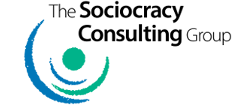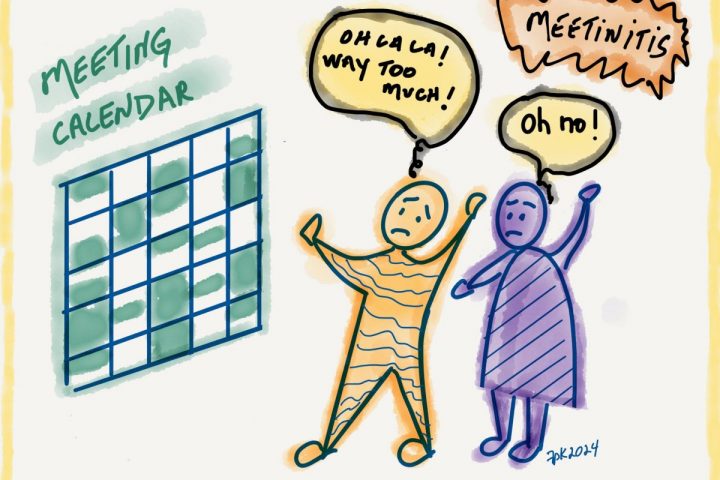
People who first hear of sociocracy often ask, “Can that help with conflict?” My short answer is usually, “Yes, it can help, depending on the cause of the conflict.” A better answer is, “Yes it can, but better yet it can help prevent conflict in the first place.”
Lack of clarity can contribute to conflict
In any group that makes decisions together, lack of clarity in several key areas can lead to conflict. When a group repeatedly butts heads with each other and has trouble coming to resolution, one question to ask is, have they all agreed on their common goals? And does everyone understand those goals to mean the same thing?
In the Sociocratic Circle-organization Method (SCM), those goals are expressed as the aims of the group. The aims are the products or services the group provides. An aim is more specific than the mission – it’s part of what the group does to carry out its mission.
Having a shared aim(s) is important in a couple of ways. If people have different aims, it is as though they are rowing a boat in different directions. Furthermore, the consent decision-making method of the SCM requires a common aim as the basis for objections. Members can object to a policy proposal if the policy would jeopardize achieving that aim – see our white paper about the SCM. If a group lacks a common aim, they also lack a clear criterion for decisions.
If people in the group are working toward different aims, the solution may be to acknowledge that and find an aim to which everyone subscribes. Or, the group may decide to split into two separate groups.
Recently a friend told me about an internal conflict around a policy decision in a grassroots organization to which she belongs. I asked her several questions: (1) Has everyone agreed on a common aim and is the aim clear? (2) Is the decision-making method clear? (3) Is it clear what sub-group makes that decision? (4) Does that sub-group have a defined membership, rather than people dropping into a meeting? The answer to three of those four questions was “no”. That’s a prescription for conflict.
A group needs clarity about the domain of decision-making for each sub-group (each “circle”, in SCM terminology). Domains should be distinct. Then it’s clear who owns which domain. The domains should include all the areas for which the group makes decisions. If domains overlap, more than one sub-group thinks something is their job. If there are gaps between domains, things can fall between the cracks and no one takes responsibility. Either is a prescription for conflict or at least frustration.
In an employee-owned company I worked with, lack of clarity about the domains led to frustration and disappointment. Worker-owners, after all, expected a voice in the company decisions. Overlap or gaps in the domains resulted in finger-pointing when issues went unaddressed or unresolved. Clarifying the domains for all areas of the company’s decisions made a huge difference. People then knew where to go to address any issue – see this case study on distributed leadership in a manufacturing company.
Above I’ve listed four questions to ask about a group experiencing conflict. Let’s continue that list. Any circle can delegate a type of decision to an individual. If they do this, then there is another set of questions: (5) Is that person’s role clearly defined? (6) Is it clear to that person and to the circle what is within that person’s domain of decisions? (7) is that person making the decisions on their own, or are they expected to seek advice first, and if so from whom? (8) Is it clear what the mechanism is if someone is affected by a decision after it is put into effect, and wants to provide feedback? A lack of clarity for any of these can be a prescription for conflict.
Here are a couple more questions to add to our list. (9) Any organization has agreements and policies that guide day-to-day operational decisions (for a discussion of policies and operational decisions in the SCM, see our white paper). Are those agreements and policies in writing? I have seen countless arguments when people had different memories of what they had decided in a meeting, even as little as two months earlier. (10) Are those written policies available for anyone in the group to see? Here’s my refrain: A lack of clarity and transparency can be a prescription for conflict.
Back to having a clear decision-making method, mentioned in question (2) above. There are multiple ways of making decisions. It is a prescription for confusion and conflict if people expect one method and it’s really another. Will one person make the decision, with or without input from others, or will the whole group decide? If the latter, will they do that by majority vote, by consensus, or by consent?
Where do we need clarity?
Clarity is key in how an organization functions. Lack of it can be a prescription for conflict. There is a flip side to this, and it’s good news. Anytime there is a conflict, we can use it as a chance to ask, where can we use more clarity? Maureen McCarthy asks that question in a couple of wonderful articles (see references below). We usually think that conflict means there is a problem, or that there are “problem people.” We can instead view the stress as a message that we care about a matter, and that we need clarity in some area. Increasing that clarity can improve the organization and the relationships within it.
What about those personality differences?
When people ask me if sociocracy can help with conflict, they are likely thinking of personality differences among people. There are several parts of my answer about that.
(a) Often what we think is a matter of individuals who have difficulty working together, actually stems from one of the ten organizational issues I’ve listed. Those issues can be hidden beneath the surface.
(b) If a couple of people have personality differences that lead to difficulty working together, any of these organizational issues can exacerbate the difficulty.
(c) Consent is foundational for making collaborative decisions in the SCM. There are clear meeting formats for every stage of making collaborative policy decisions. The use of rounds is key to each stage. Rounds help everyone be able to speak and to listen to each other. Otherwise it can be a debate where people try to bolster their own position and prove each other wrong. When a group uses rounds, new ideas emerge. I’ve seen the level of tension in a group go way down as this process progresses in a meeting. And I’ve seen the atmosphere change in an organization as they get used to using rounds in meetings. In one organization, people learned to listen to each other more both in and out of meetings. They decided they liked each other. And they started collaborating more – to the benefit both of themselves and of their customers.
(d) A group can use any method of handling conflicts between people as long as the group consents to use it. It’s a good idea for a circle to have a written agreement about what methods or resources they will draw on if and when they need it.
(e) Of course, there are situations where two people cannot work together. All members of a sociocratic circle need to consent to being in the circle together. If they know of difficulties at the outset, they can refuse that consent. In that case one or both people might join other circles in the organization. If there are persistent difficulties, a circle can withdraw consent for membership for someone in a circle. This is a last resort and is rare, but it does happen, and it’s important that there is a clear mechanism for it to happen. Personally, I want to know before joining any group if there is a clear way to accept new members, and a clear way to remove a member if the circle can no longer function. If people feel trapped with the group as it is constituted, that can be a prescription for continuing conflict. Or other people will leave, and it might not be the people you’d want to leave.
John Schinnerer, my colleague in The Sociocracy Consulting Group, is fond of saying, “There’s no human-created system that’s proof against human behavior.” There are organizational practices that can improve the odds.
Summary list
Here is a summary list of some key organizational issues that could indicate a need for more clarity when dealing with conflict. The numbers refer to my examples above.
- Common aim
- Decision-making method
- Domains of responsibility and authority
- Defined membership for circles
- Definition of roles
- Delegation
- The process by which an individual makes decisions delegated to them
- Mechanism for other individuals to give feedback on decisions made by an individual
- Agreements and policies in writing
- Transparency of written agreements – accessible to all
There’s a shorter list of key points to consider when dealing with conflict that appears to be due to personality differences:
a. The difficulty really stems from one or several organizational issues
b. Organizational issues exacerbate the difficulty
c. Clear processes for meeting formats of the SCM can help avert or address conflicts
d. The group can use any other method for handling conflicts, if they consent to use it
e. Sometimes, it really is due to personality differences. Need clear processes for accepting or removing circle members.
My impression is that personality differences – sometimes framed as “dealing with difficult people” – gets far more consideration than organizational issues. Valuable as the work on individual differences is, I suspect that organizational issues are often the true cause of difficulty, and would benefit from our attention.
References
- Maureen McCarthy, Worry vs Care: Is Stress a Warning or Message?
- Maureen McCarthy, Relationship Design in Uncertain Times
 Sheella Mierson, Ph.D., a founding member of The Sociocracy Consulting Group, consults with organizations to clarify business objectives and create adaptive structures and processes to achieve them. Contact us for a free consultation.
Sheella Mierson, Ph.D., a founding member of The Sociocracy Consulting Group, consults with organizations to clarify business objectives and create adaptive structures and processes to achieve them. Contact us for a free consultation.




